01.10.2007
I.Smikovski. The Superior League of the 60th Russia Championship: A Creative Survey (Rounds V – VII)
Frankly speaking, the "middlegame" of the tournament was not rich in aesthetics at all. The leaders kept low profiles, played circumspectly and waited for an opportunity for another spurt. There was almost dead calm on the first tables. Basically only those displeased with their tournament destiny were in a rage. And there were few of them, and they were powerless to disturb the common atmosphere that is in short can be described as outward calm and inner tension. But now it's time to switch over to chess. Andrey Rychagov obviously stepped on a gas in the middle of the tournament. The following game is his best. He has managed to outplay Vadim Zvjaginsev in purely positional vein, which is interesting in itself. Tactics helped a bit, but only on the final stage of converting the advantage. Rychagov (2557) – Zvjaginsev (2658) D38 1.d4 d5 2.c4 e6 3.¤f3 ¤f6 4.¤c3 Ґb4 5.Ґg5 ¤bd7 6.cxd5 exd5 7.Јc2 O-O 8.e3 c5 9.Ґe2 Јa5 10.O-O c4 11.¤d2 ¦e8 12.Ґh4 Ґxc3 13.bxc3 ¤e4 14.¤xe4 ¦xe4 15.Ґg3 ¦e8 16.Ґf3 ¤f6 All this previously occurred in the recent game Hammes – Smerdon, Budapest 2007. Rychagov employs a novelty associated with an idea of transposing the game into a position with bishops of opposite colors and stepping up the pressure on the Q-side gradually. 17.a4!N Ґd7 18.Ґe5 ¤g4 19.Ґxg4! Ґxg4 20.¦fb1 Јa6 21.¦b5 ¦ad8 22.¦ab1. White carries out his plan confidently, developing the initiative easily and freely. 22...Ґc8?!You wouldn't want to play 22...b6 because of 23.a5! As the following course of the game shows, c8-square is no place for the bishop; it must defend the d5-pawn. The best thing is to keep it on the f7-square with an opportunity to drive aside the rook from b5-square by means of Ґe8 when the opportunity presents itself. In this connection the variation 22...f6!? 23.Ґg3 Ґh5 24.¦1b4 ¦e7 is worth attention, and now 25.Јb2 b6 26.a5? is no good in view of 26...Ґe8! 23.a5 ¦e7 24.¦c5 Ґe6 25.h3 f6 26.Ґg3 ¦c8 27.¦cb5 Јc6 28.¦1b2 Ґf7 29.¦2b4! Placing his queen behind the rooks. 29...¦d8 30.Јb2 ¦dd7 31.¦c5 Јa6 32.¦c8+ ¦e8. After 32...Ґe8 33.¦b5 b6 34.¦b8 bxa5 35.Јa3! White wins the a5-pawn due to the threat 36.¦xd5 and begins the play against the a7- and d5-weaknesses. 33.¦c7! ¦xc7 34.Ґxc7. The material advantage is a logical result of White's consistent actions. 34...b6 35.axb6 axb6 36.¦xb6 Јa4 37.Ґg3 ¦a8 38.ўh2 h5 39.¦b7 Јd1?! More reliable is 39...¦a7 preventing the demolition of the royal shelter. 40.¦xf7! Exploiting the undefended position of the a8-rook Rychagov sacrifices an exchange for a pawn and develops a decisive attack on the black king 40...¦a1 41.¦xg7+! ўxg7 42.Јb7+ ўg6 43.Ґh4! Certainly not 43.Ґf4?? h4!°. 43...Јg1+ 44.ўg3 ¦a2 45.ўf3 Јd1+ 46.ўf4 Јb3 47.Јc8! It is important to keep the b8-square under control. The greedy 47.Јxd5?! would allow Black to count on a draw after 47...Јb8+ 48.ўe4 Јe8+ 49.ўf4 Јb8+ 50.ўf3 Јa8. 47...Јb6. The f6-pawn hangs. 48.Јg8+ ўh6 49.Јh8+ ўg6 50.Јg8+ ўh6 51.g4! The g-pawn entering the game is deadly for Black. 51...hxg4 52.hxg4 Јc7+ 53.ўf3 Јe7 54.Јxd5 ¦a1 55.Јxc4 Јb7+ 56.d5 ўg7 57.Јd4 Јf7 58.d6 1-0 Alexander Motylev had skillfully exploited his young rival's oversight and gained a solid revenge for the last year defeat. Motylev (2648) – Khairullin (2567) C49 1.e4 e5 2.¤f3 ¤c6 3.¤c3 ¤f6 4.Ґb5 Ґb4 5.O-O O-O 6.d3 d6 7.Ґxc6!? Alexander deviates from the main theoretical line and just wants to obtain a playable position. 7...bxc6 8.¤e2 Ґc5 9.Ґd2N. A useful move. The idea of b2-b4 is combined with an opportunity of developing the bishop on c3-square in case of the d6-d5-advance. 9...a5 10.¤g3 ¦e8. Ildar focuses on d6-d5, but that's not the only plan. The alternative is 10...¤e8 followed by g6, ¤g7, preparing f7-f5. 11.h3 d5 12.¦e1 Јd6 13.Ґc3! A typical provocation. Black's answer is practically forced, but let us not forget that to close the center with two bishops on the board is not very logical. 13...d4 14.Ґd2 Ґe6?! If Black had time to play ¤d7 after that, he would obtain a highly comfortable game. Ildar must have seen his opponent's tactical opportunity, but he underestimated it just a little bit. More preferable is 14...a4!? 15.¤xe5! The following events are almost forced. 15...Јxe5 16.f4 Јd6 17.e5 Јd8 18.exf6 Јxf6 19.¤e4 Јf5. 19...Јe7 looks risky but prevents the raid of the king's pawns. 20.g4! Јd5 21.f5 Ґd7 22.a4!The light-squared strategy in action. The eternal bishop in the center, the spatial advantage on the K-side and the weakness of the a5-pawn are, undoubtedly, White's achievements, but the victory is still "far, far away". 22...f6 23.Јf3 Ґf8 24.b3 ўh8 25.Ґf4 g6?! To wait passively is never easy. Black's last move is positionally sound but not well-grounded enough tactically. After 25...Ґd6 26.Јg3 Ґxf4 27.Јxf4 ¦e5 White possesses only a minimal advantage. 26.¦f1. Still stronger is 26.Јf2! – except for the capture on f6 there is a threat of an exchange on g6 followed by a check from the h4-square. 26...gxf5 27.¤xf6 Јxf3 28.¦xf3 fxg4?! This could have lead to the loss of an exchange. The correct move order, namely 28...¦e7! 29.¤xd7 fxg4! 30.hxg4 ¦xd7, leads to the position in the game. 29.hxg4. It was possible to exploit Black's oversight by way of 29.¤xe8! ¦xe8 (it is important to notice that on 29...gxf3?! there is a reply 30.Ґe5+ ўg8 31.¤f6+ ўf7 32.¤xd7) 30.hxg4 Ґxg4 31.¦f2 with a technical win. 29...¦e7 30.¤xd7 ¦xd7 31.¦e1. Black pawn structure leaves much to be desired. White's positional advantage appears great enough for a win. 31...Ґd6 32.¦e4 c5 33.ўf2 ўg8 34.¦e6 ўf7 35.¦e1 ўg7 36.Ґd2 ¦e7 37.¦xe7+ Ґxe7 38.¦f5 c6?!A considerable inaccuracy. Black loses his strong point on d6. More stubborn is 38...Ґd6 39.ўf3 ўg6 40.Ґf4 ¦e8. 39.ўf3 ўg6 40.Ґf4 ¦a7 41.¦e5 ўf6 42.ўe4 ўf7. The rook endgame after 42...Ґd6 43.¦h5 Ґxf4 44.ўxf4 is hopeless as well. 43.¦h5 ўg7 44.¦h6 Ґf6 45.g5 ¦e7+?! A "collaboration", causing an immediate denouement. 46.ўf5 1-0 Evgeny Bareev demonstrated a fresh idea in the actual variation of the Slav Defense. Alexander Lastin defended himself assiduously but did not make it. Bareev (2653) – Lastin (2583) D43 1.d4 d5 2.c4 c6 3.¤f3 ¤f6 4.¤c3 e6 5.Ґg5 h6 6.Ґh4 dxc4 7.e4 g5 8.Ґg3 b5 9.Ґe2 Ґb7 10.O-O ¤bd7 11.¤e5 h5 12.¤xd7 Јxd7 13.Ґe5 ¦h6 14.Јc1! That move that has been employed in P.H.Nielsen – Vallejo, Monaco 2006 for the first time, is now the unconditionally main continuation in this topical variation. White withdraws his queen from d1 with a tempo, vacating the square for his rook. 14...c5?! The move 14...¦g6 used to be tested much more frequently 15.d5!N. Much stronger than 15.dxc5 that occurred in Aronian – Gelfand, Monaco 2006. Bareev seeks to open up as many central lines as possible in order to launch an attack against the king. 15...b4 In case of 15...exd5 16.Ґxf6 ¦xf6 17.¤xd5 Ґxd5 there in an intermediate move 18.¦d1! that permits to keep the initiative. 16.Ґxf6 ¦xf6 17.dxe6 Јxe6. No better is 17...¦xe6 18.¦d1 Ґd6 19.¤d5 Ґxd5 20.¦xd5. 18.¤d5! An important nuance that has been provided for as early as on the move 15. 18...Ґxd5 19.exd5 Јf5. One certainly cannot grab the e2-bishop, and after 19...Јxd5 20.Ґxc4 Јf5 21.Јe3+ ўd7 22.g3 ўc7 23.a3! white threats are difficult to parry. 20.Јe3+ Ґe7 21.¦ae1! A correct idea – the bishop exchange, that will be favorable for White, is being prepared. Afterthenatural-looking 21.Ґxc4?! ўf8 followed by 22...Ґd6 White's tasks become noticeably more difficult – the passed d-pawn is securely blocked, and the light-squared bishop is hampered by it. 21...ўf8 22.Ґg4! hxg4 23.Јxe7+ ўg7 24.¦e5 Јf4 25.d6!The gallant infantryman runs on d7-square, diverting the enemy forces upon itself. In the end Alexander Lastin will manage to round it up, but too many a black pawn falls in return. 25...c3. Little is changed by 25...¦f5 26.¦e4 Јd2 27.¦xc4 ¦h8 28.d7 ¦d5 29.¦xg4±, and the attempt to give a perpetual check after 25...¦h8 26.g3 Јd2 27.d7 ¦xh2!? 28.ўxh2? ¦xf2+ 29.¦xf2 Јxf2+= is refuted by means of 28.d8Ј!ќ. 26.bxc3 bxc3 27.d7 ¦h8 28.g3 Јd2 29.Јxc5. Also possible is 29.¦xc5!? c2 30.¦c8 c1Ј 31.¦cxc1 ¦e6 32.Јc5±, keeping an extra pawn as well. 29...Јxd7 30.¦xg5+ ўh6 31.¦d5 Јc6 32.Јe3+ ўg7 33.¦c5 Јf3 34.Јd4 ¦e8 35.¦xc3 Јe4 36.Јxa7 ¦a8 37.Јc5 ¦xa2 Now the game reaches a technical phase. Further Bareev's play had not been perfect, but he did not lose his chances. 38.¦c4 Јe6 39.Јb4 ¦g6 40.¦e4 Јd7 41.Јc3+ ўg8 42.¦d4?! More precise is 42.¦fe1! 42...¦c2! 43.Јa1?! The decision to retain two rook pairs is correct. Black king is weak, so there are chances for an attack. But still stronger is 43.Јd3!, preventing the activation of black pieces. 43...¦d6! 44.¦b4 ¦c8 45.¦e1 ¦d8 46.Јc1 ¦d2. Bad is 46...¦d1? 47.¦xd1 Јxd1+ 48.Јxd1 ¦xd1+ 49.ўg2 f5 из-за 50.¦b5ќ. 47.Јb1 f5?! A decisive weakening. Now White quickly gets to the black king. Much more stubborn is 47...¦d3! 48.¦b7 Јd3 49.Јb6 Јd6 50.Јe3! Јg6 51.Јb3+ ¦2d5 52.¦ee7 Јc6 53.¦b8! ¦f8 54.¦b6 Јc1+ 55.ўg2 Јd1 56.¦g6+ ўh8 57.Јc3+ ¦d4 58.¦h6+ ўg8 59.¦g6+ ўh8 60.¦gg7. Blackresigned. On 60...¦f6 there follows 61.¦h7+ ўg8 62.¦eg7+ ўf8 63.¦d7! Јf3+ 64.Јxf3 gxf3+ 65.ўxf3 with absolutely won position. 1-0 Evgeny Tomashevsky won two fine games, although the "resistive capacity" of his opponents was poles apart. Let's study the workmanlike victory first, namely a fragment of a game in which he had to find new resources in order to keep the initiative all the time. Tomashevsky (2654) – Novikov (2562) 15.h4! Evgeny makes use of particular features of the position. This is the only way to tilt the balance in his favor. 15...¦c8 16.¤g5+! ўg8 17.¤e4 Ґg7 18.h5!A brave decision. It is extremely dangerous for Black to take the pawn. 18...g5. On 18...Ґxh5 there would follow 19.Јd2! f5 (entirely bad is 19...ўh7? 20.g4! Ґxg4 21.Ґxh6) 20.¤c3 ўh7 21.¤d5 ¤c6 (if 21...e5, then 22.g4! fxg4 23.Ґe4) 22.¤f4 Јa5 23.Јxa5 ¤xa5 24.¤xh5 gxh5 25.¦xh5± with an advantage in the ending. 19.Јd2. Making the opponent take into consideration the offer of the bishop on g5 and preparing f2-f4 at the same time. 19...Ґf5. 19...¤c6 is risky in view of 20.Ґxg5! hxg5 21.Јxg5 ўh8 (21...Јa5+ 22.¤d2) 22.Јxg4 f5 23.Јg5! (23.Јg6 ¤e5) 23...fxe4 24.Ґxe4, and on 19...ўh8 there is a fine reply 20.f4. 20.g4! Continuing in the same vein. 20...Ґxe4. In case of 20...Ґxg4 there is 21.Ґxg5! hxg5 (21...ўh7 22.Ґf4) 22.Јxg5 ўh8 (22...f5? 23.h6 ¦f7 24.Јg6) 23.Јxg4, and Black cannot play 23...f5? because of 24.Јg6 fxe4 25.Ґxe4ќ. 21.Ґxe4 ¤c6! Stanislav Novikov keeps his head in the alarming situation. Only the exchange of the queens can save him from an attack along the b1-h7 diagonal. 22.f4. Apparently, Evgeny fails to find an opportunity to evade the exchange (probably, there is no such an opportunity at all) and decided to content himself with a somewhat better endgame. 22...gxf4 23.Ґxf4 Јa5 24.Јxa5 ¤xa5 25.g5. Opening of the g-file is unpleasant for Black, but by accurate play he is able to build strong defensive resources. 25...¤c6 26.gxh6 Ґb2 27.¦d1. Worth attention is 27.¦c2!? Ґe5 28.e3 bringing his rook into play along the second rank. 27...f5 28.Ґd5+ ўh8 29.ўf2 Ґe5 30.e3?!It may not be worth it to give up the d4-square at the opponent's complete command. More preferable is 30.Ґg5. 30...Ґxf4 31.exf4 ¤d4. Alas, the powerful knight is no guaranty against defeat. In a couple of moves Black makes a blunder. 32.¦de1 ¦ce8 33.Ґe6 33...¦d8? Black shouldn't have rejected the only 33...¦f6! 34.Ґd7 ¦g8 35.¦xe7 ¦g4 with quite good counterplay. 34.¦hg1 ¦f6 35.¦g6. The threat of the invasion along the vertical together with the attack on the e7-pawn brings success. 35...¦df8. If 35...¦xe6 36.¦exe6 ¤xe6 37.¦xe6 ¦e8, then 38.ўg3ќ, and white king's breakthrough decides the issue. 36.Ґd5 e6 37.Ґxe6 ўh7 38.Ґg8+! ўh8 39.¦e7! ¦xg6 40.hxg6 ўxg8 41.h7+ 1-0 And now another, surprisingly easy success. The opponent had made some barely noticeable mistakes and was defeated in a model textbook manner. Tomashevsky (2654) – Panarin (2529) D94 1.c4 c6 2.¤f3 d5 3.e3 ¤f6 4.¤c3 g6 5.d4. The ancient Schlechter Variation with a changed move order is an unwonted enough guest in the modern tournament practice. 5...Ґg7 6.Ґe2 O-O 7.O-O a6 8.Ґd2 dxc4 9.Ґxc4 Ґg4 10.h3 Ґxf3 11.Јxf3 ¤bd7 12.¦fd1 e5 13.Ґb3 Јe7 14.¦ac1 14...¤b6?N. An extremely unhappy novelty. Knights are well-known for being allergic to the b6-square. In this particular case Black finds himself in trouble because he loses his grip on the center. Stronger is previously employed 14...¦fe8. 15.dxe5! Forcing an inappropriate centralization of the queen. 15...Јxe5 16.e4!The pawn advantage in the center and on the K-side in the presence of the bishop pair is a very weighty factor. 16...¤bd7. This is really an admission of an error on the move 14. 17.Ґf4 Јa5 18.Ґd6! This move and the following one have a common goal: to prepare the advance of the e- and f-pawns and to constrict the opponent as much as possible. 18...¦fe8 19.Јe3! Ґf8?! This move serves to precipitate the outcome. More stubborn is 19...¦ad8, although after 20.f4 ¤b6 21.e5 Ґf8 22.Ґxf8 ¦xd1+ 23.¦xd1 ўxf8 24.Јd4 ¤fd5 25.¤e4± it goes hard with Black. 20.Јf4 Ґxd6 21.¦xd6 Јe5. Leads to material losses, but I already cannot suggest anything instead. 22.Јxe5 ¦xe5 23.¦cd1 ¦e7 24.f4! Black resigned, as there is no satisfactory defense from 25.e5. 1-0 In the next game some more moves had been made, but there was no real struggle as well. PavelSmirnovactedmuch tooadventurously. Smirnov (2636) – Zakhartsov (2559) B90 1.e4 c5 2.¤f3 d6 3.d4 cxd4 4.¤xd4 ¤f6 5.¤c3 a6 6.Ґe3 ¤g4 7.Ґg5 h6 8.Ґh4 g5 9.Ґg3 Ґg7 10.h3 ¤e5 11.f3 ¤bc6 12.Ґf2 12...¤g6!? A fashionable version of the variation. Black plans massive exchanges of the minor pieces on the d4-square. 13.Јd2 ¤xd4. Preventing the hair-raising 13...Јa5 14.¤d5! Јxd2+ 15.ўxd2 Ґxd4 16.Ґxd4 ¤xd4 17.¤c7+ ўd7 18.¤xa8І, as it occurred in Karjakin – Grischuk, Dagomys 2007. 14.Ґxd4 Ґxd4 15.Јxd4 Ґe6 16.g3. 16.h4 Јa5 17.hxg5 does not promise anything to write home about. In this position a draw was agreed in Khairullin – V.Popov, Tomsk 2006. 16...Јa5!?N. Viacheslav is not concerned about the f3-f4 advance. 17.f4?! And Pavel just cannot stop himself. After the unpretentious 17.Ґe2 there is a rough equality on the board. 17...gxf4 18.gxf4 O-O-O! Stressing the ephemerality of the threat f4-f5. 19.f5 ¤e5. While White is distracted by defense of the f3-square, Black places his pieces in an ideal manner. 20.Ґe2?! Aggravates the problems, although after 20.Јf2 Ґc4 21.a3 Black also has an advantage. 20...Ґc4! 21.Ґh5 ¦hg8 22.¦g1. If 22.O-O-O, then 22...¦g5. 22...¤c6! Making the most of the position. After the knight gets to b4-square, White really seems to have had it. 23.Јf2 ¦xg1+ 24.Јxg1 ¤b4 25.O-O-O. After 25.Јf2 ¦g8 it's not easy to find any acceptable move for White. 25...¤xa2+ 26.¤xa2 Јxa2 27.Јd4 ўb8 28.e5 ¦c8!It's nice to attack the king with an extra pawn in store. 29.exd6 Ґb3! 30.ўd2 Јa5+. 30...¦xc2+? 31.ўe3 exd6 32.Јxd6+ leads only to a draw. 31.ўe3 Ґxc2 32.d7 ¦d8 33.¦c1?!That leaves White with no chances at all. It seems worth it to try and live till endgame by way of 33.Јd5. 33...Ґxf5! Viacheslav is accurate to the end. White can win a bishop, but will be mated for his troubles. 34.b4 Јb5 35.¦c5 Јxd7 36.Јe5+ ўa7 37.Ґe2 (37.Јxf5 Јd2+ 38.ўf3 ¦d3+°) 37...Јd2+ 38.ўf2 Ґd3 0-1 A quiet opening seemed to promise nothing special in Ildar Khairullin's game vs. Konstantin Landa, but the internal tension was building up and finally spilled over into a furious pawn clash in the center. Khairullin (2567) – Landa (2669) White appears not to have anything special. With his next move Ildar makes his opponent face problems that the latter eventually fails to solve. 16.d4! ¦d8. An attempt to equalize immediately by way of 16...¤xe4 17.¤xe4 dxe4 18.Ґxe4 Ґc4 19.¦e1 exd4 reckoning on 20.¤xd4 ¦xe4! 21.¦xe4 ¤xd4 22.¦xd4 Ґxd4 23.Јxd4= hits on intermediate 20.b3!, and Black has to part with an exchange – 20...¦xe4 (entirely sad is 20...Ґe6 21.¤xd4±) 21.¦xe4 Ґd5 22.¦e1І. On 16...exd4!? there follows 17.e5 ¤d7 (after 17...d3 18.Ґxd3 ¤d7 19.Ґxb5 ¤cxe5 20.¤xe5 Ґxe5 21.Ґxh6 White is a pawn up) 18.cxd4 ¤b4 19.Ґd2! ¤xc2 20.Јxc2, and the lagged-behind c-pawn together with the possibility of loosening the foundations on the K-side by means of h4-h5 determine the evaluation of the position as favorable for White. Better is 16...dxe4 17.¤xe5! (17.¤xe4 Ґc4 18.¦e1 exd4 gives nothing) 17...¤a5! 18.¦e1 Ґd5 – instead of the weakness on e4-square Black obtains play in the center and on the Q-side. 17.¤xe5 dxe4?! Immediately giving back a pawn with following activation of the pieces - 17...¤xe5 18.dxe5 dxe4 19.Јe1 ¤d7 20.Ґxe4 Јa2 21.f4 ¤c5! - promises better chances for counterplay. 18.¤g4! A precise move stressing white advantage. 18...¤xg4 19.hxg4 Јc8. Other continuations promise no leveling as well: 19...¤e5 20.g5 e3!? 21.Ґxe3 ¤c4 22.Јc1!±; 19...Ґd5 20.¦e1 ¦e8 21.Ґf4!±. 20.g5! hxg5 21.Ґxe4. Both the knight and the g5-paw hang – White gets material advantage. 21...¤e5 22.Ґxg5 f6 23.Ґh4?! Stronger is 23.Ґf4! 23...g5? That's what Ildar counted on. In case of 23...c5! 24.d5 (24.f4 ¤g4 25.Ґxg6 ¤e3) 24...Ґf7 White would have more problems as he has to take care of the h4-bishop and d5-pawn. Now Konstantin gets under an attack that can almost be called crushing. 24.Јh5! gxh4 25.Јh7+ ўf8 26.¤h5 Јd7 27.dxe5 f5.There was a threat 28.exf6, and on 27...fxe5 there is a terrible blow 28.f4! 28.Ґc6! Ґg8 29.Јg6 Јf7 30.Јg5. Black resigned – on the withdrawal of the rook there is a decisive move 31.e6! 1-0 And in conclusion there are three endings. Here we will see instructive mistakes, precise calculations of the variations, and exotic study-like ideas.. Maletin (2567) – Rublevsky (2679) White has an extra pawn, though it is double, and Black has a bishop pair at that. Objectively speaking, the position is equal. Pavel Maletin tries to wring at least some advantage out of it and gets into a jam. 32.¤b2. There is a possibility of 32.¤xb6 cxb6=, after which the opponents could have safely signed the scoresheets. 32...a5 33.Ґc4?! The idea of exchanging bishops is incorrect. More promising is 33.e4!? 33...axb4 34.axb4? A decisive blunder. After the only 34.¤d3+! ўd6 35.Ґxd5 ўxd5 36.axb4 ўc4 37.¤f4! White should have made a draw. Now punishment follows. 34...Ґxc4! In all probability, it was general consideration saying that exchanges are favorable for the party having material advantage that had let Pavel down. Here we deal with an exception – in spite of the lack of a pawn Black can afford transposing into a pawn ending which is actually won, as the active king, the weakness of white pawns and lots of tempi to spare tilt the balance in Black's favor. 35.¤xc4+ ўe4 36.b5. Loses 36.¤xb6 cxb6 37.ўc3 b5! 38.ўd2 f5°, and the attempt of 36.ўc3 (threatening to take on b6 and to move the king on c4) is simply neutralized by means of 36...Ґa7! (a step back in order to make two steps forward – before transposing the game into the pawn endgame it is useful to win some tempi) 37.ўd2 (37.b5 Ґc5!) 37...f5 38.ўc3 (38.h4 h6) 38...Ґxe3 39.¤xe3 (or 39...Ґg1) 39...ўxe3 40.ўc4 ўxe2 41.ўd5 g5 42.ўe5 f4 43.gxf4 gxf4 44.ўxf4 ўd3!°. 36...f5 37.h4. On 37.ўc3 Sergey Rublevsky would play 37...g5! and not 37...Ґxe3? 38.¤xe3 ўxe3 39.ўc4 ўxe2 40.ўc5 g5 41.ўc6 f4 42.ўxc7! (erroneous is 42.gxf4? in view of 42...gxf4 43.ўxc7 f3 44.b6 f2 45.b7 f1Ј 46.b8ЈЈf4+ 47.ўc8 Јxb8+ 48.ўxb8 ўf3 49.ўc7, and after that the win is gained by 49...ўg2! 50.h4 ўg3! 51.h5 ўg4! 52.h6 ўg5!°) 42...f3 43.b6 f2 44.b7 f1Ј 45.b8Ј, and White has practical chances for an escape. 37...h6 38.ўc3 g5 39.hxg5 hxg5 40.ўb4 g4 41.ўc3 Ґxe3 0-1 Smirnov (2636) – Novikov (2562) Nominally Black possesses an adequate material equivalent – two pawns for an exchange, - but his king and knight are too far off from the extremely dangerous b6-pawn. 31.¦f3?! Pavel Smirnov could have made use of his positional advantage by means of an energetic 31.b7! ўe7 32.¦a1 ўd6 33.¦a8 ўc7 34.¦f3 ¤g4 35.¦xb8 ўxb8 36.¦xf7 ¤e5 37.¦xh7 ўxb7 38.ўe3 ¤xc4+ 39.ўd4 ¤b6 40.¦g7ќwit a won endgame. Now the road to victory becomes rather winding. 31...¤g4 32.c5 ўe7 33.¦a3 ¤e5 34.¦a7 ¦c8 35.¦b1 ¤c6 36.¦b7. A wise move. The immediate 36.¦c7 automatically comes to mind. 36...h5 37.¦c7 ўd8 38.¦xc6! In order to prevent blockade (38.¦xc8+ ўxc8 39.ўe3 ўb7 ) Pavel returns the extra exchange. 38...dxc6 39.¦d1+? Missing the opportunity to win once and for all. Success is achieved by invading the 7th rank – 39.¦a1! Despite his two extra pawns Black is completely helpless: 39...g5 (if 39...ўe7 40.¦a7+ ўf6, then 41.¦c7! ¦b8 42.¦xc6ќ, and the connected "self-propelled" pawnsdecide the issue) 40.¦a7 f6 (or 40...f5 41.ўe3 e5 42.¦f7 h4 43.¦xf5 ўd7 44.¦xg5 ¦a8 45.ўe4ќ) 41.ўe3 ¦b8 42.¦f7 ўc8 43.ўd4 e5+ 44.ўe4 h4 45.¦c7+ ўd8 46.¦xc6 ўe7 47.ўf5ќ. 39...ўe7 40.¦d6 g5 41.ўe3 h4 42.¦xc6! An elegant but not so effective move. 42...¦xc6! Loses 42...ўd7? 43.¦d6+ ўe7 in view of 44.ўd4! g4 (in the pawn endgame after 44...¦d8 45.¦xd8 ўxd8 46.c6ќwhite king comes to d6-square, and the pawns queen with mating threats) 45.ўc4ќ, and two connected pawns supported by the king are much stronger than its black "colleagues". 43.b7 ¦xc5 44.b8Ј. White has a queen now, but there is a fortress on the board. The following course of the game did not change the evaluation of the position in the least. 44...¦f5 45.Јg8 ўf6 46.Јh7 ¦f4 47.Јh6+ ўf5 48.Јh5 f6 49.Јe8 e5 50.Јh5 ¦e4+ 51.ўf2 ¦f4+ 52.ўe3 ¦e4+ 53.ўf2 ¦f4+ 54.ўg1 ўe4 55.Јh7+ ўe3 56.Јd7 ўe2 57.Јb5+ ўd2 58.Јb3 e4 59.Јb2+ ўe1 60.Јc2 e3 61.Јd3 e2 62.Јc2 ¦f1+ 63.ўh2 g4 64.Јc1+ ўf2 65.Јf4+ ўe1 66.Јc1+.White has no reason to reject a perpetual check – after 66.Јxg4 ¦f2 67.Јxh4 ўf1 68.Јc4 ¦xg2+ 69.ўh3 f5= he has no chance of winning. Ѕ-Ѕ Makarov (2518) – Tregubov (2599) Possessing a solid advantage Black imprudently advanced his pawn as far as the h2-square and by this created the necessary prerequisites for a stalemating combination. 51.¦d2! An efficient and very attractive way to a draw. 51...¦xd2 52.¦xf5+! ўh6 53.¦h5+ ўg7 54.¦h7+ ўf6 55.¦f7+ ўe6 56.¦e7+ ўd5 57.¦e5+ ўc4 58.¦c5+.The h2-pawn is doubly protected, and that makes the White's task easier. 58...ўd4 59.¦c4+ ўd5 60.¦c5+ ўe4 61.¦e5+ ўf3 62.¦e3+ ўf2 63.¦f3+ There is nowhere to hide from the crazyrook, so Black resigned himself to a peaceful outcome. Ѕ-Ѕ And here I would like to wind up with my not-so-extensive survey. The finish lies ahead, so I hope that participators will show their worth and the situation in the tournament will further perkiness and intransigence.
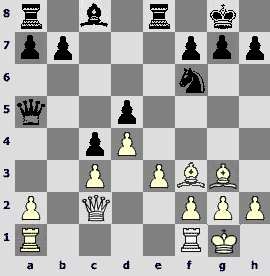
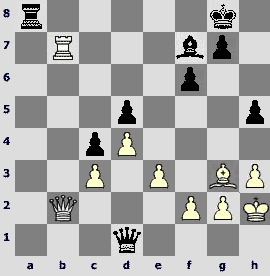

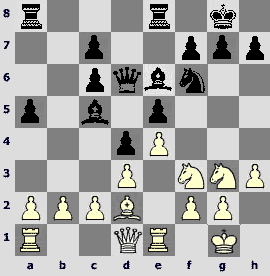
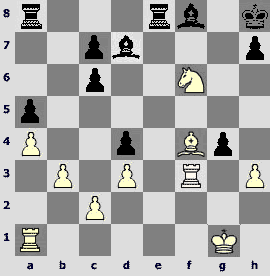
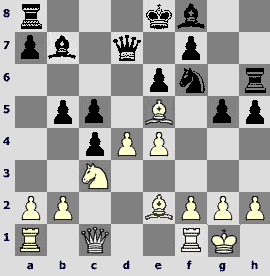
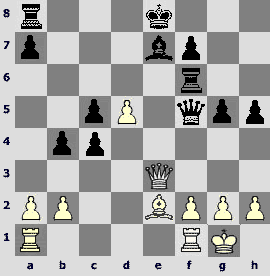

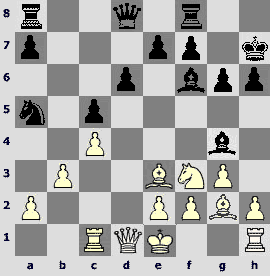
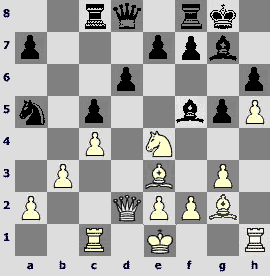
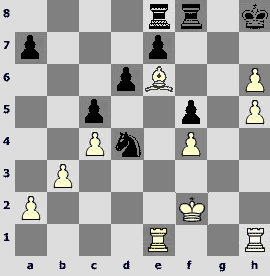
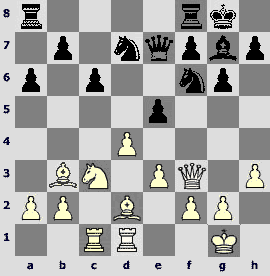
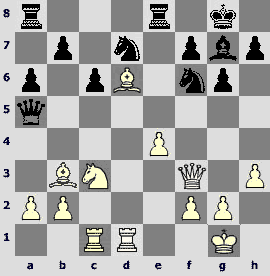
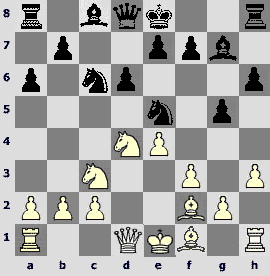
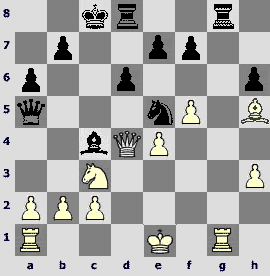
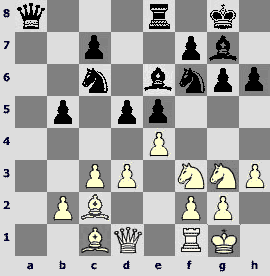
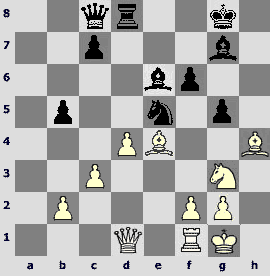
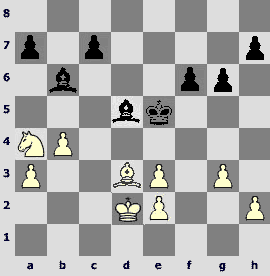
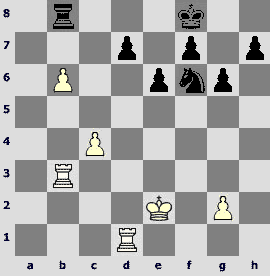

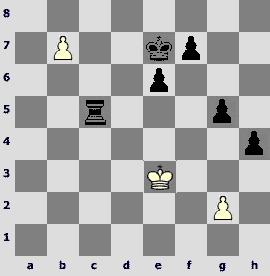
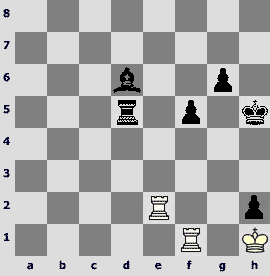
ALL ARTICLES BY AUTHOR

Discuss in forum